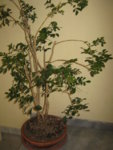murraya is a popular bonsai species in asia. growers in taiwan, philippines and other south east asian countries create high quality bonsai from this material. while murraya abound in hawaii, primarily as hedge or landscape plantings, it is underutilized as bonsai material. here is one of mine, collected from an old hedge near my house. the wood is very hard. the bark smooth. the leaves are small and shiny green. in season, the tree bears clusters of scented white flowers very much like orange blossoms. flowers transition into bright red berries which make for a nice presentation. recent work included removing old wire, rewiring where necessary, and light pruning to define branch pads. in the first photos compare the start of work on the left side to the stock appearance on the right. a crossing root at the base has been removed for a cleaner look. as the foliage grows back and the apex develops, the straight upper trunk will be less noticeable
best wishes, sam




best wishes, sam








